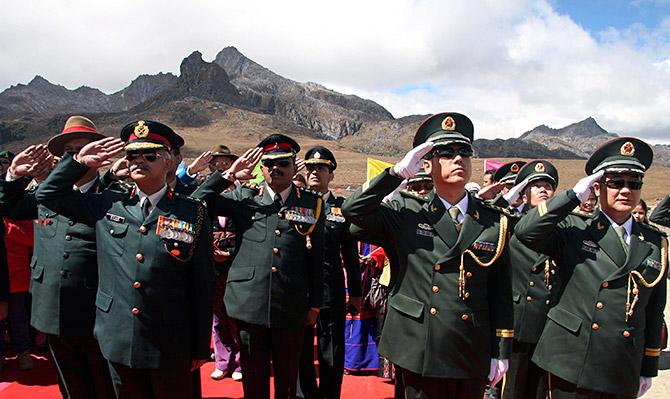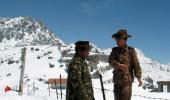The operational alert allows troops to get acclimatised to high altitudes, renovate the bunkers and trenches from which they would fight, break out ammunition, and carry out the coordination needed to fight an integrated defensive battle.
Ajai Shukla reports.

Although army planners are not expecting a Chinese attack on the disputed Doklam bowl, where some 150 Indian soldiers have been in an eyeball-to-eyeball face-off against some 40 Chinese border guards since June, the army is taking no chances.
Villagers in Nathang, a border village 10 to 12 kilometres as the crow flies from Doklam, have been asked to evacuate their homes and move elsewhere.
Nathang is overlooked directly by mountain features at Doklam, like Gyemochen, which China claims as the disputed India-China-Bhutan tri-junction.
Another Indian village nearby, Kuppup, is significantly closer to the border. But it is shielded from the Doklam area by high mountains that Indian troops occupy.
Army spokespersons deny the military has asked for Nathang to be evacuated. The civilian administration, however, is unlikely to have taken such a step unilaterally.
Simultaneously, two Indian mountain divisions -- the 17 Division, headquartered in Gangtok, and the 27 Division, based in Kalimpong -- are discreetly moving troops to their battle stations on the Sikkim-Tibet border, including areas far removed from Dolkam.
Military sources downplay this move as "precautionary."
Says one senior officer: "We have our annual operational alert in October every year. This year, because of the tension at Doklam, we have advanced it by a couple of months."
The operational alert allows troops to get acclimatised to high altitudes, renovate the bunkers and trenches from which they would fight, break out ammunition, and carry out the coordination needed to fight an integrated defensive battle.
Even as the army takes these precautions, policymakers in New Delhi are optimistic that diplomacy would resolve the issue without the need for military action.
"This is China's 'Kargil moment', where a crisis has been created by gung-ho military commanders, who appear to have misled the leadership in Beijing that India would quietly accept Chinese road-building in Doklam," says a former top diplomat with decades of experience in dealing with China.
"Although Beijing knows it has erred, China cannot pull back without losing face. That means the faceoff will continue at least until the 19th National Congress of the Communist Party of China, most likely to be held in October,"says the former diplomat.
"Xi Jinping is not going into that crucial Congress from a position of weakness given that his leadership for the next five years will be shaped there," the former diplomat adds.
Yet China would face significant military disadvantages in mounting a frontal attack to evict Indian troops from Doklam.
This would involve advancing through the narrow Chumbi valley, overlooked by Indian troops deployed on the heights.
Even an airborne strike, like the spectacular staged for Xi Jinping at Zhurihe on July 31, on the PLA's (People's Liberation Army) 90th anniversary, would find it difficult to dislodge Indian troops at Doklam without using massive air power and escalating the crisis dramatically.
Asked about military options that could provide China with a face-saver, a senior general believes the PLA might choose to occupy another strategic border pass, such as the 17,500 foot Lipulekh on the India-China-Nepal tri-junction.
Lipulekh is controlled by India, but is also claimed by Nepal, providing a striking parallel with the India-China-Bhutan context at play at Doklam.
"China could occupy Lipulekh, and use that as a face-saver for a mutual withdrawal from Doklam. Then, after the 19th Party Congress is concluded, all sides could return to the status quo," projects the general, speaking off the record.
Army spokespersons state that the situation at Doklam remains unchanged. However, they are not willing to speak about the number of troops confronting each other.
China has about 1,500 troops to the north of Doklam, while India has about 600 troops to the west, backed up by two army brigades further away.
IMAGE: Indian and Chinese soldiers attend celebrations to mark the 60th anniversary of the founding of the People's Republic of China at the India-China border, about 41 km from Tawang district in Arunachal Pradesh, October 1, 2009. Photograph: Utpal Baruah/Reuters











 © 2025
© 2025